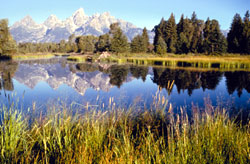 |
|
 |


The Teton Range (NPS Photo) |
 |
Located in northwestern Wyoming, Grand Teton National Park protects stunning mountain scenery and a diverse array of wildlife. Rising more than 7,000 feet above the valley of Jackson Hole, the Teton Range dominates the park’s skyline. Natural processes continue to shape the ecosystem against this impressive and recognizable backdrop.
The elevation of the park ranges from 6,400 feet on the sagebrush-dominated valley floor to 13,770 feet on the windswept granite summit of the Grand Teton. Between the summit and plain, forests carpet the mountainsides. During summer, wildflowers paint meadows in vivid colors. Crystalline alpine lakes fill glacial cirques, and noisy streams cascade down rocky canyons to larger lakes at the foot of the range. These lakes, impounded by glacial debris, mirror the mountains on calm days. Running north to south, the Snake River winds its way down the valley and across this amazing scene.
Long, snowy, and bitterly cold winters make the climate of Jackson Hole unforgiving. The coldest temperature ever recorded in Grand Teton National Park was –63°F, and snow often blankets the landscape from early November to late April. Brief, relatively warm summers provide a respite from the rigors of winter and a time of renewal and rebirth. In cooperation or competition, the plants and animals adapt to this harsh climate and dramatic elevation change as each finds ways to survive.
|
|
|


